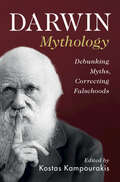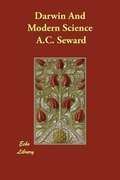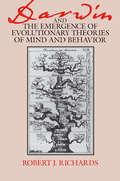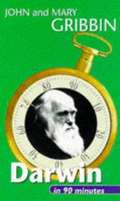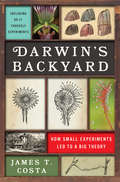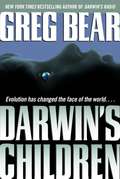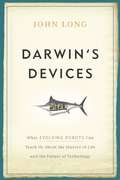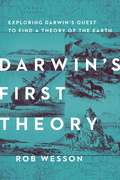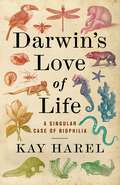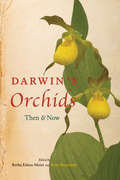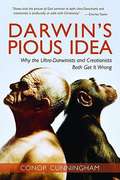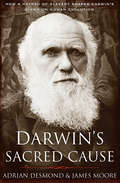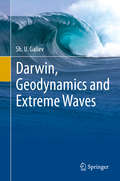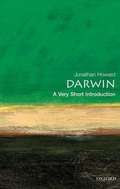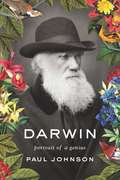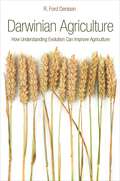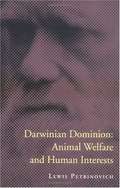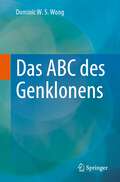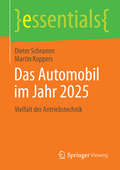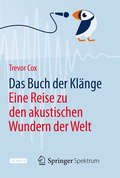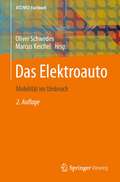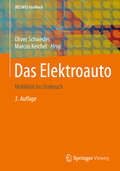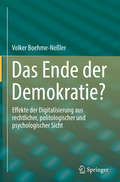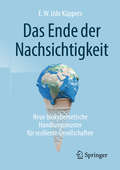- Table View
- List View
Darwin Mythology: Debunking Myths, Correcting Falsehoods
by Kostas KampourakisMany historical figures have their lives and works shrouded in myth, both in life and long after their deaths. Charles Darwin (1809–82) is no exception to this phenomenon and his hero-worship has become an accepted narrative. This concise, accessible and engaging collection unpacks this narrative to rehumanize Darwin's story and establish what it meant to be a 'genius' in the Victorian context. Leading Darwin scholars have come together to argue that, far from being a lonely genius in an ivory tower, Darwin had fortune, diligence and – crucially – community behind him. The aims of this essential work are twofold. First, to set the historical record straight, debunking the most pervasive myths and correcting falsehoods. Second, to provide a deeper understanding of the nature of science itself, relevant to historians, scientists and the public alike.
Darwin and Evolution for Kids: His Life and Ideas with 21 Activities (For Kids series)
by Kristan LawsonDarwin and Evolution for Kids traces the transformation of a privileged and somewhat scatterbrained youth into the great thinker who proposed the revolutionary theory of evolution. Through 21 hands-on activities, young scientists learn about Darwin's life and work and assess current evidence of evolution. Activities include going on a botanical treasure hunt, keeping field notes as a backyard naturalist, and tying knots for ship sails like those on the HMS Beagle. Children also learn how fossils are created, trace genetic traits through their family trees, and discover if acquired traits are passed along to future generations. By encouraging children, parents, and teachers to define the differences between theories and beliefs, facts and opinions, Darwin and Evolution for Kids does not shy away from a theory that continues to spark heated public debate more than a century after it was first proposed.
Darwin and Modern Science
by A. C. SewardThe Cambridge Philosophical Society collected this series of essays in commemoration of the centenary of the birth of Charles Darwin and the 50th anniversary of the publication of The Origin of Species. Aiming to be accessible to the 'educated layman', the eminent contributors reviewed the impact of Darwin's ideas in many spheres. They addressed contemporary (1909) attitudes, Darwin's theories and their far-reaching implications, and the progress of new lines of research that had emerged from them. The diversity of views among biologists regarding both the origin of species and the best directions for further research is clearly evident. In his work, Darwin had sought only the truth, writing 'Absolute accuracy is the hardest merit to attain, and the highest merit. Any deviation is ruin.' However dramatic the controversies he stirred, what shines from these essays is profound admiration for both Darwin's intellect and the quality of his character.
Darwin and the Emergence of Evolutionary Theories of Mind and Behavior
by Robert J. Richards edited by David L. HullWith insight and wit, Robert J. Richards focuses on the development of evolutionary theories of mind and behavior from their first distinct appearance in the eighteenth century to their controversial state today. Particularly important in the nineteenth century were Charles Darwin's ideas about instinct, reason, and morality, which Richards considers against the background of Darwin's personality, training, scientific and cultural concerns, and intellectual community. Many critics have argued that the Darwinian revolution stripped nature of moral purpose and ethically neutered the human animal. Richards contends, however, that Darwin, Herbert Spencer, and their disciples attempted to reanimate moral life, believing that the evolutionary process gave heart to unselfish, altruistic behavior. "Richards's book is now the obvious introduction to the history of ideas about mind and behavior in the nineteenth century. "—Mark Ridley, Times Literary Supplement "Not since the publication of Michael Ghiselin's The Triumph of the Darwinian Method has there been such an ambitious, challenging, and methodologically self-conscious interpretation of the rise and development and evolutionary theories and Darwin's role therein. "—John C. Greene, Science "His book . . . triumphantly achieves the goal of all great scholarship: it not only informs us, but shows us why becoming thus informed is essential to understanding our own issues and projects. "—Daniel C. Dennett, Philosophy of Science
Darwin in 90 Minutes
by John Gribbin Mary GribbinIn this easy-to-read series, eminent science writers John and Mary Gribbin look at the lives and work of eight major scientists. Each book is accessible enough to be read for fun but informative enough to appeal to students of science. The iconic Albert Einstein emerges as a dashing ladies' man and the greatest scientist of his time; but why did Charles Darwin wait for decades before going public with his ideas on evolution? How was Marie Curie's great work shaped by her childhood experiences of oppression under the Czars? And what was Edmond Halley, of comet fame, doing as Captain of a King's Ship and later spy for the Crown? An introduction and afterword places each scientist's work in the context of the development of their subject.
Darwin's Backyard: How Small Experiments Led To A Big Theory
by James T. CostaDarwin’s Backyard goes beyond the portrait of Charles Darwin as a brilliant thinker to concentrate on him as a nimble experimenter delving into some of evolution’s great mysteries. James T. Costa takes readers on a journey from Darwin’s childhood through his voyage on the HMS Beagle where his ideas on evolution began. We then follow Darwin to Down House, his bustling home of forty years, where he kept porcupine quills at his desk to dissect barnacles, maintained a flock of sixteen pigeon breeds in the dovecote, and cultivated climbing plants in the study, and to Bournemouth, where on one memorable family vacation he fed carnivorous plants in the soup dishes. Using his garden and greenhouse, the surrounding meadows and woodlands, and even taking over the cellar, study, and hallways of his home-turned-field-station, Darwin tested ideas of his landmark theory of evolution with an astonishing array of hands-on experiments that could be done on the fly, without specialized equipment. He engaged naturalists, friends, neighbors, family servants, and even his children, nieces, nephews, and cousins as assistants in these experiments, which involved everything from chasing bees and tempting fish to eat seeds to serenading earthworms. From the experiments’ results, he plumbed the laws of nature and evidence for the revolutionary arguments of On the Origin of Species and his other watershed works. Beyond Darwin at work, we accompany him against the backdrop of his enduring marriage, chronic illness, grief at the loss of three children, and joy in scientific revelation. This unique glimpse of Darwin’s life introduces us to an enthusiastic correspondent, crowd-sourcer, family man, and, most of all, an incorrigible observer and experimenter. Includes directions for eighteen hands-on experiments, for home, school, yard, or garden.
Darwin's Children (Darwin #2)
by Greg BearGreg Bear's Nebula Award-winning novel,Darwin's Radio, painted a chilling portrait of humankind on the threshold of a radical leap in evolution--one that would alter our species forever. Now Bear continues his provocative tale of the human race confronted by an uncertain future, where "survival of the fittest" takes on astonishing and controversial new dimensions. DARWIN'S CHILDREN Eleven years have passed since SHEVA, an ancient retrovirus, was discovered in human DNA--a retrovirus that caused mutations in the human genome and heralded the arrival of a new wave of genetically enhanced humans. Now these changed children have reached adolescence . . . and face a world that is outraged about their very existence. For these special youths, possessed of remarkable, advanced traits that mark a major turning point in human development, are also ticking time bombs harboring hosts of viruses that could exterminate the "old" human race. Fear and hatred of the virus children have made them a persecuted underclass, quarantined by the government in special "schools," targeted by federally sanctioned bounty hunters, and demonized by hysterical segments of the population. But pockets of resistance have sprung up among those opposed to treating the children like dangerous diseases--and who fear the worst if the government's draconian measures are carried to their extreme. Scientists Kaye Lang and Mitch Rafelson are part of this small but determined minority. Once at the forefront of the discovery and study of the SHEVA outbreak, they now live as virtual exiles in the Virginia suburbs with their daughter, Stella--a bright, inquisitive virus child who is quickly maturing, straining to break free of the protective world her parents have built around her, and eager to seek out others of her kind. But for all their precautions, Kaye, Mitch, and Stella have not slipped below the government's radar. The agencies fanatically devoted to segregating and controlling the new-breed children monitor their every move--watching and waiting for the opportunity to strike the next blow in their escalating war to preserve "humankind" at any cost.
Darwin's Devices: What Evolving Robots Can Teach Us About the History of Life and the Future of Technology
by John LongWhat happens when we let robots play the game of life? The challenge of studying evolution is that the history of life is buried in the past--we can't witness the dramatic events that shaped the adaptations we see today. But biorobotics expert John Long has found an ingenious way to overcome this problem: he creates robots that look and behave like extinct animals, subjects them to evolutionary pressures, lets them compete for mates and resources, and mutates their 'genes'. In short, he lets robots play the game of life. In Darwin's Devices, Long tells the story of these evolving biorobots--how they came to be, and what they can teach us about the biology of living and extinct species. Evolving biorobots can replicate creatures that disappeared from the earth long ago, showing us in real time what happens in the face of unexpected environmental challenges. Biomechanically correct models of backbones functioning as part of an autonomous robot, for example, can help us understand why the first vertebrates evolved them. But the most impressive feature of these robots, as Long shows, is their ability to illustrate the power of evolution to solve difficult technological challenges autonomously--without human input regarding what a workable solution might be. Even a simple robot can create complex behavior, often learning or evolving greater intelligence than humans could possibly program. This remarkable idea could forever alter the face of engineering, design, and even warfare. An amazing tour through the workings of a fertile mind, Darwin's Devices will make you rethink everything you thought you knew about evolution, robot intelligence, and life itself.
Darwin's First Theory: Exploring Darwin's Quest For A Theory Of Earth
by Rob WessonAn acclaimed geologist leads the reader on an adventure through the landscape that absorbed and inspired Charles Darwin. Everybody knows—or thinks they know—Charles Darwin, the father of evolution and the man who altered the way we view our place in the world. But what most people do not know is that Darwin was on board the HMS Beagle as a geologist—on a mission to examine the land, not flora and fauna. Retracing Darwin’s footsteps in South America and beyond, geologist Rob Wesson treks across the Andes, cruises waters charted by the Beagle, hunts for fossils in Uruguay and Argentina, and explores sites of long vanished glaciers in Scotland and Wales. As he follows Darwin’s path—literally and intellectually—Wesson experiences the land as Darwin did, engages with his observations, and tackles the same questions Darwin had about our ever-changing Earth. Upon his return from his five-year journey aboard the Beagle, after examining the effects of earthquakes, tsunamis, volcanic eruptions, and more, Darwin conceived his theory of subsidence and uplift‚—his first theory. These concepts and attitudes—the vastness of time; the enormous cumulative impact of almost imperceptibly slow change; change as a constant feature of the environment—underlie Darwin’s subsequent discoveries in evolution. And this peculiar way of thinking remains vitally important today as we enter the human-dominated Anthropocene age. Expertly interweaving science and adventure, Darwin’s First Theory is a riveting and revelatory journey around the world with one of the greatest scientific minds in history.
Darwin's Love of Life: A Singular Case of Biophilia
by Karen L. HarelBiophilia—the love of life—encompasses the drive to survive, a sense of kinship with all life-forms, and an instinct for beauty. In this unconventional book, Kay Harel uses biophilia as a lens to explore Charles Darwin’s life and thought in deeply original ways. In a set of interrelated essays, she considers how the love of life enabled him to see otherwise unseen evolutionary truths.Harel traces the influence of biophilia on Darwin’s views of dogs, facts, thought, emotion, and beauty, informed by little-known material from his private notebooks. She argues that much of what Darwin described, envisioned, and felt was biophilia in action. Closing the book is a profile of Darwin’s marriage to Emma Wedgwood, his first cousin, a woman gifted in music and medicine who shared her husband’s love of life.Harel’s meditative, playful, and lyrical musings draw on the tools of varied disciplines—aesthetics, astronomy, biology, evolutionary theory, history of science, philosophy, psychiatry, and more—while remaining unbounded by any particular one. Taking unexpected paths to recast a figure we thought we knew, this book offers readers a different Darwin: a man full of love, joy, awe, humility, curiosity, and a zest for living.
Darwin's Orchids: Then and Now
by Retha Edens-Meier Peter BernhardtFor biologists, 2009 was an epochal year: the bicentennial of Charles Darwin’s birth and the 150th anniversary of the publication of a book now known simply as The Origin of Species. But for many botanists, Darwin’s true legacy starts with the 1862 publication of another volume: On the Various Contrivances by Which British and Foreign Orchids Are Fertilised by Insects and on the Good Effects of Intercrossing, or Fertilisation of Orchids. This slim but detailed book with the improbably long title was the first in a series of plant studies by Darwin that continues to serve as a global exemplar in the field of evolutionary botany. In Darwin’s Orchids, an international group of orchid biologists unites to celebrate and explore the continuum that stretches from Darwin’s groundbreaking orchid research to that of today. Mirroring the structure of Fertilisation of Orchids, Darwin’s Orchids investigates flowers from Darwin’s home in England, through the southern hemisphere, and on to North America and China as it seeks to address a set of questions first put forward by Darwin himself: What pollinates this particular type of orchid? How does its pollination mechanism work? Will an orchid self-pollinate or is an insect or other animal vector required? And how has this orchid’s lineage changed over time? Diverse in their colors, forms, aromas, and pollination schemes, orchids have long been considered ideal models for the study of plant evolution and conservation. Looking to the past, present, and future of botany, Darwin’s Orchids will be a vital addition to this tradition.
Darwin's Pious Idea: Why the Ultra-Darwinists and Creationists Both Get It Wrong
by Conor CunninghamIn "Darwin's Pious Idea," Cunningham puts forth a compelling, cutting-edge case for both creation and evolution, drawing skillfully on an array of philosophical, theological, historical, and scientific sources to buttress his arguments.
Darwin's Sacred Cause: How a Hatred of Slavery Shaped Darwin's Views on Human Evolution
by James Moore Adrian DesmondAn &“arresting&” and deeply personal portrait that &“confront[s] the touchy subject of Darwin and race head on&” (The New York Times Book Review). It&’s difficult to overstate the profound risk Charles Darwin took in publishing his theory of evolution. How and why would a quiet, respectable gentleman, a pillar of his parish, produce one of the most radical ideas in the history of human thought? Drawing on a wealth of manuscripts, family letters, diaries, and even ships&’ logs, Adrian Desmond and James Moore have restored the moral missing link to the story of Charles Darwin&’s historic achievement. Nineteenth-century apologists for slavery argued that blacks and whites had originated as separate species, with whites created superior. Darwin, however, believed that the races belonged to the same human family. Slavery was therefore a sin, and abolishing it became Darwin&’s sacred cause. His theory of evolution gave a common ancestor not only to all races, but to all biological life. This &“masterful&” book restores the missing moral core of Darwin&’s evolutionary universe, providing a completely new account of how he came to his shattering theories about human origins (Publishers Weekly, starred review). It will revolutionize your view of the great naturalist. &“An illuminating new book.&” —Smithsonian &“Compelling . . . Desmond and Moore aptly describe Darwin&’s interaction with some of the thorniest social and political issues of the day.&” —Wired &“This exciting book is sure to create a stir.&” —Janet Browne, Aramont Professor of the History of Science, Harvard University, and author of Charles Darwin: Voyaging
Darwin, Geodynamics and Extreme Waves
by Sh. U. GalievThis book examines the reasons behind the resonant amplification of seismic and ocean waves that have the capacity to destroy cities and ocean-going vessels. Using Charles Darwin's important geophysical research as a starting point, it provides insights into the interaction between earthquakes with volcanoes, seaquake, and tsunami formation. In particular, the author details the observations that Darwin made on a powerful earthquake that occurred in Chile in 1835, noting how the famous naturalist and geologist used the concept of earthquake-induced vertical shock to explain the event's devastating impact. The book then goes on to show how Darwin's concept relates to the catastrophic results of the shallow quakes that recently destroyed Port-au-Prince (Haiti, 2010) and severely damaged Christchurch (New Zealand, 2011). In addition, the author asks whether Darwin's ideas are endorsed by the discoveries of modern science and whether the results of destructive earthquakes can be modeled using strongly nonlinear wave equations. Coverage also proposes that similar equations can be used to simulate the dynamics of many objects on the surface of the Earth, and to model the origin of the Universe, dark matter, and dark energy as strongly nonlinear wave phenomena. The book will appeal to students as well as researchers and engineers in geophysics, seismology, nonlinear wave studies, cosmology, physical oceanography, and ocean and coastal engineering. It will also be of use to those who are interested in the phenomena of natural catastrophes as well as those who want to learn more about the life and work of Charles Darwin.
Darwin: A Very Short Introduction
by Jonathan HowardDarwin's theory that man's ancestors were apes caused an uproar within the scientific world, as well as public frenzy when The Origin of Species was published in 1859. Arguments still rage about the implications of his evolutionary theory, and skepticism about the value of Darwin's contribution to knowledge is widespread. In this analysis of Darwin's major insights and arguments, Jonathan Howard reasserts the importance of Darwin's work for the development of modern biology. He offers a stimulating view of the famous scientist in a concise, handy format, making it a masterpiece for all Darwinians as well as for all general readers of popular science.
Darwin: portrait of a genius
by Paul JohnsonEminent historian Paul Johnson provides a rich, succinct portrait of Charles Darwin Charles Darwin is arguably the most influential scientist of all time. His Origin of Species forever changed our concept of the world’s creation. Darwin’s revolutionary career is the perfect vehicle for historian Paul Johnson. Marked by the insightful observation, spectacular wit, and highly readable prose for which Johnson is so well regarded, Darwin brings the gentleman-scientist and his times brilliantly into focus. From Darwin’s birth into great fortune to his voyage aboard the Beagle, to the long-delayed publication of his masterpiece, Johnson delves into what made this Victorian gentleman into a visionary scientist—and into the tragic flaws that later led Darwin to support the burgeoning eugenics movement. Johnson’s many admirers as well as history and science buffs will be grateful for this superb account of Darwin and the everlasting impact of his discoveries. .
Darwinian Agriculture: How Understanding Evolution Can Improve Agriculture
by R. Ford DenisonHarnessing evolution for more sustainable agricultureAs human populations grow and resources are depleted, agriculture will need to use land, water, and other resources more efficiently and without sacrificing long-term sustainability. Darwinian Agriculture presents an entirely new approach to these challenges, one that draws on the principles of evolution and natural selection.R. Ford Denison shows how both biotechnology and traditional plant breeding can use Darwinian insights to identify promising routes for crop genetic improvement and avoid costly dead ends. Denison explains why plant traits that have been genetically optimized by individual selection—such as photosynthesis and drought tolerance—are bad candidates for genetic improvement. Traits like plant height and leaf angle, which determine the collective performance of plant communities, offer more room for improvement. Agriculturalists can also benefit from more sophisticated comparisons among natural communities and from the study of wild species in the landscapes where they evolved.Darwinian Agriculture reveals why it is sometimes better to slow or even reverse evolutionary trends when they are inconsistent with our present goals, and how we can glean new ideas from natural selection's marvelous innovations in wild species.
Darwinian Dominion: Animal Welfare and Human Interests
by Lewis PetrinovichThe controversial subject of this book is the permissible use of animals by humans. Lewis Petrinovich argues that humans have a set of cognitive abilities, developing from a suite of emotional attachments, that make them unique among species.
Das ABC des Genklonens
by Dominic W. WongDieses klare und übersichtliche Buch bietet einen Einführungskurs in die Sprache des Genklonens und deckt dabei mikrobielle, pflanzliche und Säugetiersysteme ab. Es stellt die Grundlagen des Genklonens in einer gut organisierten und zugänglichen Weise dar. Teil I dieses Buches umreißt die Grundlagen der Biologie und Genetik, die für das Konzept des Genklonens relevant sind. Teil II beschreibt gängige Techniken und Ansätze des Genklonens, angefangen von den grundlegenden Mechanismen der DNA-Manipulation, Vektorsystemen, Prozesstransformation bis hin zur Genanalyse. In Teil III und IV werden Anwendungstechnologien vorgestellt, die in der Landwirtschaft, Biomedizin und verwandten Bereichen von großer Bedeutung sind. Das ABC des Genklonens, dritte Auflage, enthält Aktualisierungen, darunter ein Tutorial-Kapitel über die Konstruktion von Genvektoren, Methoden zur Exom-Sequenzierung bei der Suche nach Krankheitsgenen, überarbeitete Themen zur Gentherapie und zur Ganzgenom-Sequenzierung, neue Entwicklungen zum Gen-Targeting und zur Genom-Editierung sowie den aktuellen Stand des Next Generation Sequencing. Mit mehr als 140 Abbildungen ist diese neue Ausgabe ein unschätzbarer Text für Studenten und alle, die die Sprache des Genklonens lesen und sprechen wollen.
Das Automobil im Jahr 2025: Vielfalt der Antriebstechnik (essentials)
by Dieter Schramm Martin KoppersDer Paradigmenwechsel von verbrennungsmotorischen zu (teil-)elektrifizierten Antrieben bei Pkw wird über 2025 hinaus zu einer großen Diversität der Antriebskonzepte führen. Diese Vielfalt wird von verbrennungsmotorischen Antrieben auf Basis fossiler und synthetischer Kraftstoffe über Hybridantriebe bis hin zu elektrischen Antrieben reichen. Die technische und wirtschaftliche Beherrschung dieser Vielfalt ist die Herausforderung für Fahrzeughersteller und Zulieferer in den kommenden Jahrzehnten. Andererseits eröffnet diese Entwicklung Industrie und Gesellschaft hinsichtlich der Wertschöpfungs- und Arbeitsplatzpotenziale, z. B. durch neue Vermarktungskonzepte, völlig neue Möglichkeiten. Allerdings erfordert sie auch Überzeugungsarbeit, um der neuen Technik mit ihren Potentialen zum Durchbruch zu verhelfen.
Das Buch der Klänge: Eine Reise zu den akustischen Wundern der Welt
by Trevor CoxMit dem Buch der Klänge führt uns der britische Wissenschaftler Trevor Cox in verborgene Hörwelten. Es weckt in uns das Verlangen, in einem Alltag, in dem das Visuelle so sehr dominiert, doch einmal genauer hinzuhören - und unsere Ohren für das wunderbare Klangdurcheinander um uns herum zu öffnen. Als Fachmann für technische Akustik hat sich Trevor Cox lange damit beschäftigt, unerwünschte Geräusche verschwinden zu lassen, ob Echos in Konzertsälen oder Lärm in Klassenzimmern. Eines Tages aber verschaffte ihm ein Ausflug in die Londoner Kanalisation ein erstaunliches Hörerlebnis - und die Erkenntnis: Statt seltsame Geräusche abzustellen, sollten wir die seltsamsten und bizarrsten akustischen Effekte zu schätzen lernen: als die Klangwunder unserer Erde. Das Buch der Klänge beschreibt seine Suche nach diesen Klangwundern. In der Mojave-Wüste besucht Cox singende Dünen. In Frankreich entdeckt er ein Echo, das zu Scherzen aufgelegt ist. In Kalifornien fährt er eine ,,singende" Straße entlang, die die Ouvertüre zu Wilhelm Tell erklingen lässt (wenn auch ziemlich schief). Und eine Entdeckung ist so beeindruckend, dass sie einen Eintrag ins Guinness-Buch der Rekorde verdient hat.
Das Elektroauto: Mobilität im Umbruch (ATZ/MTZ-Fachbuch)
by Oliver Schwedes Marcus KeichelDer Band widmet sich dem Elektroauto. Es wird der Frage nachgegangen, inwieweit das Elektroauto als Teil einer neuen Mobilitätskultur einen Beitrag zu einer nachhaltigen Verkehrsentwicklung leisten kann. Dabei wird neben der technischen, die kulturelle, politische, soziale und ästhetische Dimension betrachtet. Es wird gezeigt, wie sich die gesamtgesellschaftlichen Rahmenbedingungen ändern müssen, um dem Elektroauto zum Erfolg zu verhelfen.
Das Elektroauto: Mobilität im Umbruch (ATZ/MTZ-Fachbuch)
by Oliver Schwedes Marcus KeichelDer Band widmet sich dem Elektroauto. Es wird der Frage nachgegangen, inwieweit das Elektroauto als Teil einer neuen Mobilitätskultur einen Beitrag zu einer nachhaltigen Verkehrsentwicklung leisten kann. Dabei wird neben der technischen, die kulturelle, politische, soziale und ästhetische Dimension betrachtet. Es wird gezeigt, wie sich die gesamtgesellschaftlichen Rahmenbedingungen ändern müssen, um dem Elektroauto zum Erfolg zu verhelfen.
Das Ende der Demokratie?
by Volker Boehme-NeßlerWie verändert sich die Demokratie durch die Digitalisierung? Dieser Frage geht das Buch aus verfassungsrechtlicher, technikrechtlicher, politikwissenschaftlicher und psychologischer Sicht nach. Dazu arbeitet es zunächst die Charakteristika von Digitalisierung heraus. Es fragt, wie sich die Digitalisierung auf das Denken, das Verhalten und die (politische) Kommunikation auswirkt. Auf dieser Grundlage vertritt der Autor die These, dass sich die Demokratie grundlegend verändern muss und wird. Im letzten Teil skizziert er, wie die Demokratie konkret im digitalen Zeitalter funktionieren könnte.
Das Ende der Nachsichtigkeit: Neue biokybernetische Handlungsmuster für resiliente Gesellschaften
by E. W. KüppersDer Autor dieses Buches bespricht kleine adaptive Fortschritte, die ganzheitliches vernetztes Denken und Handeln voraussetzen, aus dem eine systemstabilisierende Wirkung erwächst. Biokybernetik und Deglobalisierung verfolgen ähnliche Prinzipien. Daher sind beide sehr geeignet, um das Metaziel Nachhaltigkeit zu stärken.
